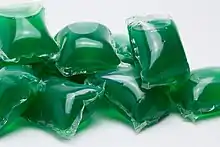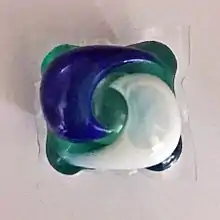Laundry detergent pod
Laundry detergent pods (or packs or liquitabs) are water-soluble pouches containing highly concentrated laundry detergent, softener and other laundry products. Notable brands of these packs include All, Arm & Hammer, Gain, Purex, Persil and Tide.[1] They first became popular in February 2012 when they were introduced by Procter & Gamble as Tide Pods.[1]

The chemistry of laundry detergent packs is the same as in liquid detergents (including alkylbenzenesulfonates). The dissolvable packets are typically made of polyvinylalcohol (PVA) or a derivative of PVA. Although the formulas are similar, a detergent pack's liquids may contain 10% water compared to 50% in liquid detergents.[2]
MonoSol is one of the companies that develops the water-soluble film used for laundry and dishwasher detergent packs, used by brands including Tide, with roughly $250 million in annual sales and controlling around 90-percent of the market.[3] The film is designed to be soluble in cold water.[4]
Laundry pods are estimated to make up about 15% of the $7 billion-a-year U.S. laundry detergent market sales according to market researcher Nielsen NV. Laundry pods were advertised as a way to reduce wasted use of powdered and liquid detergent by having precise measurements for a load. For large loads, most brands recommend two pods, with Tide suggesting up to three. Detergent pods cost significantly more than liquid detergent for equivalent laundry loads.[5][6]
History
Laundry tabs were originally introduced in the 1960s in a compacted granular form (similar to an oral medical tablet), when Procter & Gamble launched Salvo tablets, later disappearing from the market in the 1970s. In the 1990s, Unilever and Henkel launched a similar laundry detergent pack product sold in Western Europe under the Persil brand. These products sometimes did not fully dissolve in United States washers.[7][8] Laundry pods were introduced into the European market in 2001 as liquitabs or capsules.
In 2005, Cot’n Wash, Inc., introduced liquid unit dose laundry pods under the Dropps brand.[9]
In 2012, Procter & Gamble launched a liquid tablet product as Tide Pods.[1]
In 2017, the "Tide Pod Challenge" emerged causing more concern about laundry detergent pod poisoning. [10]
Poisonings

Concern has been raised over children accidentally being exposed to laundry packs, as its appearance and the packaging design can have the same appeal to a child as hard candy with patterned designs, and be confused as such. [11]
In 2012, in response to a child swallowing Tide Pods, Procter & Gamble said they would make this product more difficult to open by adding a double latch to the lid, and has also re-focused their advertising to make clear the product should be out of a child's reach at all times. The packaging was also changed to an opaque orange rather than the original clear plastic gumball machine-type presentation to make them look less enticing; other manufacturers followed suit with equivalent packaging changes.[12] In 2013, Consumer Reports stated that there had been nearly 7,700 reported incidents in which children age 5 or younger had been exposed to laundry pacs,[1] and that year, one child from Florida died after ingesting a pac.[13] In 2014, a study published in Pediatrics found that from 2012 to 2013, more than 17,000 calls were made to poison control centers about children who had been exposed to the packs.[14] Despite the industry's move toward safer packaging, a 2017 study published in JAMA Ophthalmology found that between 2012 and 2015, the number of chemical eye burns associated with laundry detergent pods among 3- to 4-year-old children skyrocketed from fewer than 20 to almost 500 per year; in 2015, these injuries were responsible for 26% of all chemical eye burns among this population.[15]
In late 2017 and early 2018, a viral Internet trend, called the "Tide Pod Challenge" emerged, in which participants deliberately and intentionally ingested detergent pods, in some cases filming the consumption of the detergent and the aftermath. Several children and teens have been injured, some severely, from this intentional consumption.[16]
References
- "Laundry detergent pods remain a health hazard". Consumer Reports. March 2013. Archived from the original on 12 November 2014. Retrieved 11 November 2014.
- "BACKGROUND INFORMATION ON THE PROPOSED GREEN SEAL™ STANDARD FOR LAUNDRY CARE PRODUCTS (2012)" (PDF). Retrieved 11 November 2016.
- "The so-secretive company behind Tide Pod detergent packs". Crain's Chicago Business. Retrieved 12 November 2016.
- "Tide PODS Factsheet" (PDF). Retrieved 11 November 2016.
- "Tide's Answer To Slumping Sales? Use More Detergent Pods!". Consumerist. 8 June 2016. Retrieved 12 November 2016.
- Ziobro, Paul; Terlep, Sharon (8 June 2016). "Three Tide Pods a Wash? Procter & Gamble Pushes More Doses". Wall Street Journal. ISSN 0099-9660. Retrieved 12 November 2016.
- "P&G Reinvents Laundry With $150 Million Tide Pods Launch". Retrieved 12 November 2016.
- https://www.deseret.com/platform/amp/2000/7/27/19520326/unilever-airs-plans-to-introduce-laundry-detergent-in-tablet-form
- "Winning Consumers Dropps by Dropps". HAPPI. Retrieved 9 May 2017.
- Ritschel, Chelsea (13 January 2018). "Tide pod challenge: Teenagers are risking death to film themselves eating Tide pods". The Independent. Retrieved 7 July 2019.
- Jaslow, Ryan (19 October 2012). "CDC warns laundry detergent pods pose health risk". CBS News. Retrieved 15 November 2014.
- Wohl, Jessica (25 May 2012). "Tide to change Pods lid over child safety concerns". Reuters. Retrieved 11 November 2014.
- Mendoza, Dorrine (16 August 2013). "Baby dies after ingesting laundry detergent pod". CNN. Retrieved 15 November 2014.
- Valdez, A. L.; Casavant, M. J.; Spiller, H. A.; Chounthirath, T.; Xiang, H.; Smith, G. A. (10 November 2014). "Pediatric Exposure to Laundry Detergent Pods". Pediatrics. 134 (6): 1127–1135. doi:10.1542/peds.2014-0057. PMID 25384489.
- Haring, R. S.; Sheffield, I. D.; Frattaroli, S (2 February 2017). "Detergent Pod–Related Eye Injuries Among Preschool-Aged Children". JAMA Ophthalmology. 135 (3): 283–284. doi:10.1001/jamaophthalmol.2016.5694. PMID 28152145. S2CID 41092172.
- Carroll, Linda. "Coma, deaths: More children harmed by eating laundry pods". TODAY.com. Retrieved 12 January 2018.